Report on Compensation Management Practices at Air Asia Company
VerifiedAdded on 2021/02/20
|20
|6976
|80
Report
AI Summary
This report provides a comprehensive analysis of Air Asia's compensation management practices. It begins with an introduction to compensation, its importance, and various elements like base pay and incentive plans. The report then details Air Asia's compensation strategy, including its background and current practices, such as flexible working hours, bonuses, and travel benefits. It also outlines the responsibilities of compensation administration within the company. The main body of the report delves into compensation objectives, covering topics like attracting and retaining employees, boosting morale, and maintaining work-life balance. It further examines internal alignment, considering factors like laws and regulations, organizational strategy, and HR policies. The report also discusses external competitiveness, emphasizing the importance of setting competitive pay structures. The report includes analyses of the current practices, general critiques, and contributions of Air Asia's compensation management. The report is based on information available up to the time it was written.
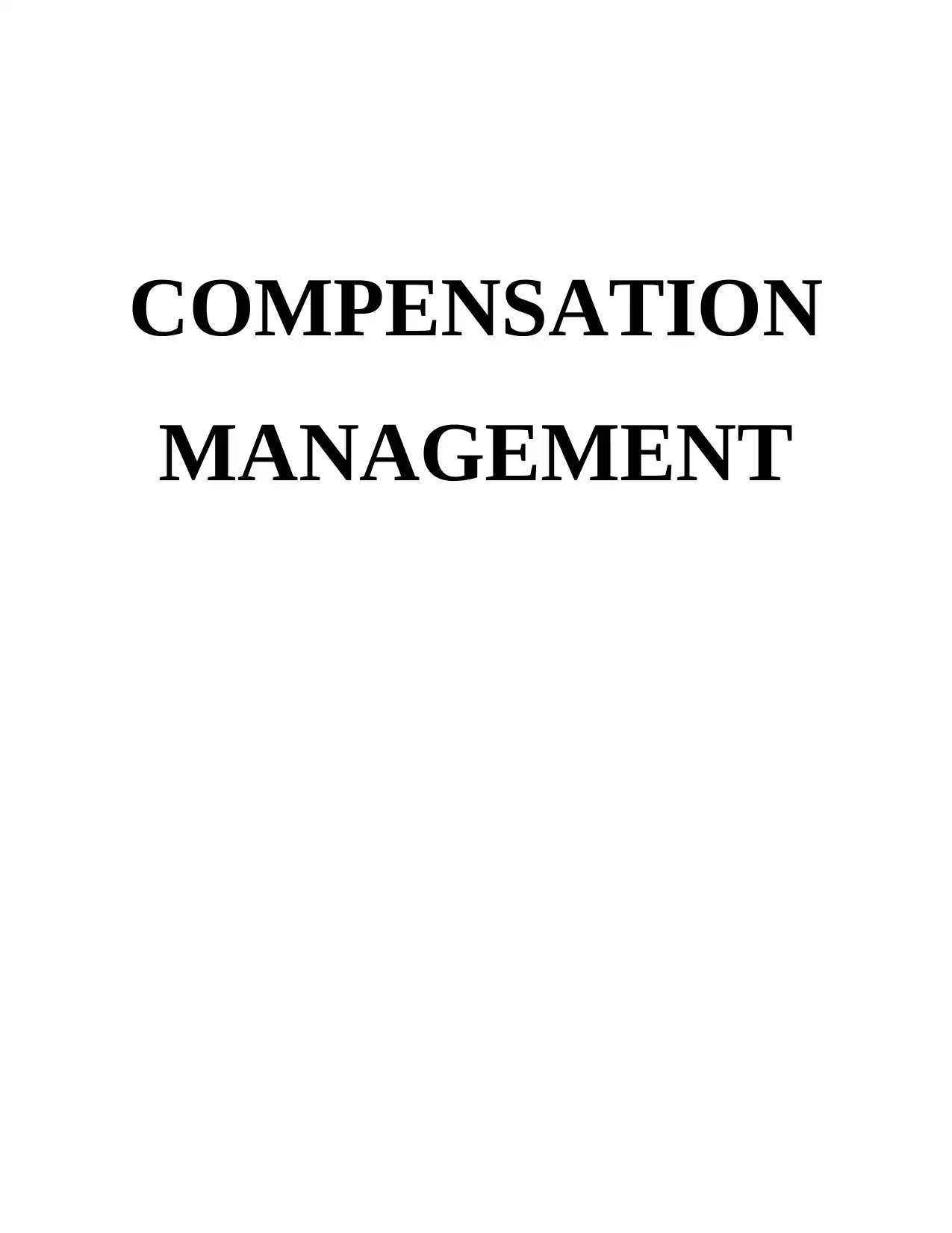
COMPENSATION
MANAGEMENT
MANAGEMENT
Paraphrase This Document
Need a fresh take? Get an instant paraphrase of this document with our AI Paraphraser
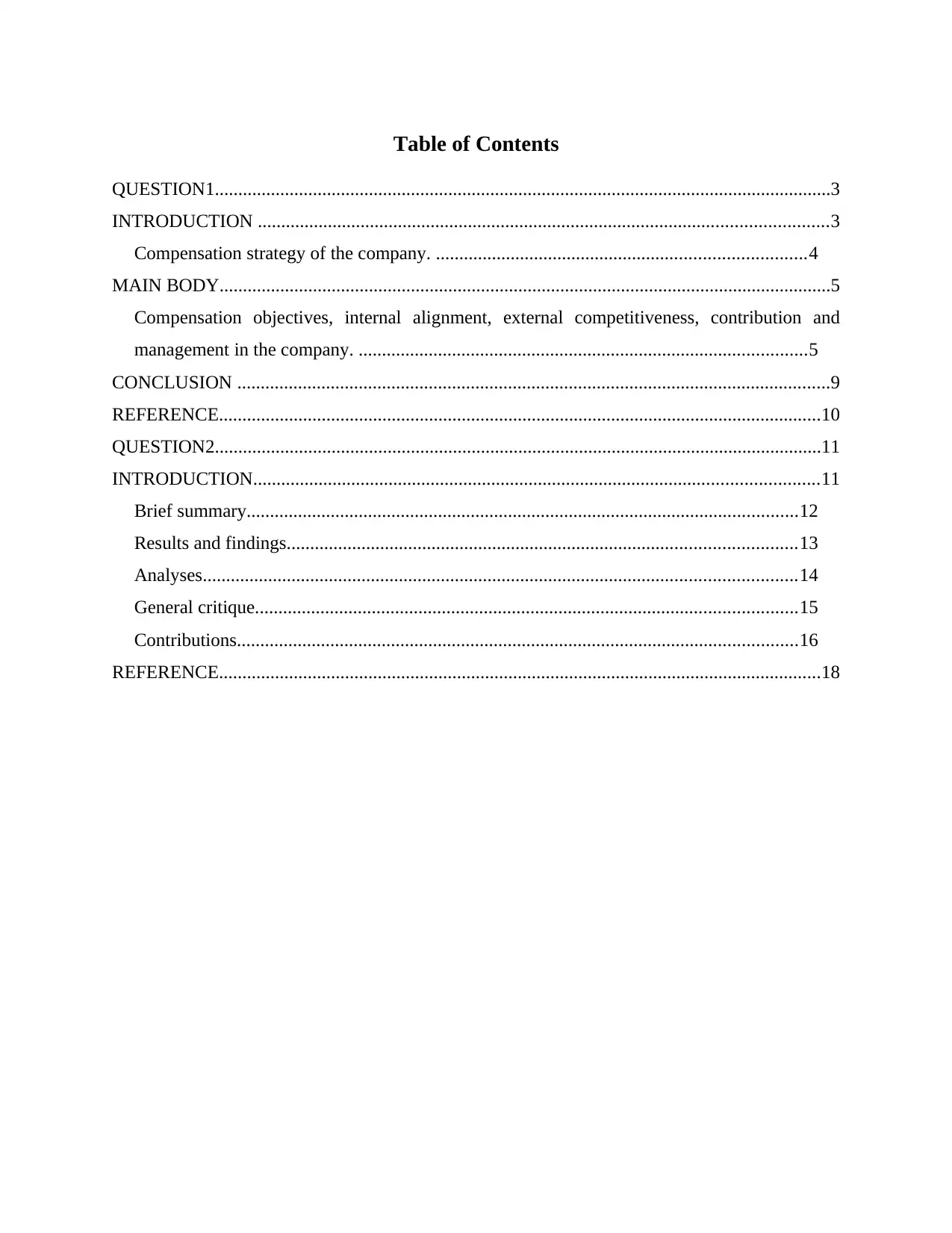
Table of Contents
QUESTION1....................................................................................................................................3
INTRODUCTION ..........................................................................................................................3
Compensation strategy of the company. ...............................................................................4
MAIN BODY...................................................................................................................................5
Compensation objectives, internal alignment, external competitiveness, contribution and
management in the company. ................................................................................................5
CONCLUSION ...............................................................................................................................9
REFERENCE.................................................................................................................................10
QUESTION2..................................................................................................................................11
INTRODUCTION.........................................................................................................................11
Brief summary......................................................................................................................12
Results and findings.............................................................................................................13
Analyses...............................................................................................................................14
General critique....................................................................................................................15
Contributions........................................................................................................................16
REFERENCE.................................................................................................................................18
QUESTION1....................................................................................................................................3
INTRODUCTION ..........................................................................................................................3
Compensation strategy of the company. ...............................................................................4
MAIN BODY...................................................................................................................................5
Compensation objectives, internal alignment, external competitiveness, contribution and
management in the company. ................................................................................................5
CONCLUSION ...............................................................................................................................9
REFERENCE.................................................................................................................................10
QUESTION2..................................................................................................................................11
INTRODUCTION.........................................................................................................................11
Brief summary......................................................................................................................12
Results and findings.............................................................................................................13
Analyses...............................................................................................................................14
General critique....................................................................................................................15
Contributions........................................................................................................................16
REFERENCE.................................................................................................................................18

QUESTION1
1.INTRODUCTION
1.1 Compensation is the amount of money in form of cash or non cash which the
organisation gives to the employees and employers. This is very important for every business
and is also treated as the largest expense for the organisations because every successful
organisation is existing and generating profits with the help of employees and employers who are
working for acquiring a reliable benefit in form of compensation (Uddin and. et. al., 2014). This
compensation will help them in living a standardised life and fulfil the requirements of families.
It includes different elements like salaries, wages, bonuses, etc. This will be very helpful in an
organisation for the employees as it will motivate them, develop and provide them future career
opportunities and assures that they are committed towards the accomplishment of business goals
and objectives. Thus, this is most effective tool through which the employees can be rewarded
and managed effectively and efficiently.
1.2 The competitive base pay is concerned with providing an assurance on the rate or amount
of money for which the employee will work and it is decided between the organisation and
employee before the actual work starts. The competitive salary is the salary provided by
company above the standard price or rate of jobs which is prevailing in the market industry. It is
different and varies from person to person depending on their skills and capabilities. This salary
or pay is the exclusion of additional pay which includes different bonuses, on call compensation,
rewards, over time work, etc. The company sets the base for the employees because it enhances
their position in relation to the seniority and positioning in the hierarchical structure of the
organisation.
1.3 Incentive plans are the methods in which employees of the organisation are kept
motivated on regular basis and they are given incentives when they accomplishes the business
targets and goals effectively and efficiently (Gupta, 2014). There is no level of theses incentives
plans and it can be given to all the levels of employees including lower level, middle level and
upper level. These plans play a very critical and important role because it helps in attracting and
retaining the customers in the organisation. Such plans are very useful in inspiring and
promoting positive atmosphere in the organisation. They must have proper set of goals and
objectives because if the company lacks proper objectives then this will discourage the morale
1.INTRODUCTION
1.1 Compensation is the amount of money in form of cash or non cash which the
organisation gives to the employees and employers. This is very important for every business
and is also treated as the largest expense for the organisations because every successful
organisation is existing and generating profits with the help of employees and employers who are
working for acquiring a reliable benefit in form of compensation (Uddin and. et. al., 2014). This
compensation will help them in living a standardised life and fulfil the requirements of families.
It includes different elements like salaries, wages, bonuses, etc. This will be very helpful in an
organisation for the employees as it will motivate them, develop and provide them future career
opportunities and assures that they are committed towards the accomplishment of business goals
and objectives. Thus, this is most effective tool through which the employees can be rewarded
and managed effectively and efficiently.
1.2 The competitive base pay is concerned with providing an assurance on the rate or amount
of money for which the employee will work and it is decided between the organisation and
employee before the actual work starts. The competitive salary is the salary provided by
company above the standard price or rate of jobs which is prevailing in the market industry. It is
different and varies from person to person depending on their skills and capabilities. This salary
or pay is the exclusion of additional pay which includes different bonuses, on call compensation,
rewards, over time work, etc. The company sets the base for the employees because it enhances
their position in relation to the seniority and positioning in the hierarchical structure of the
organisation.
1.3 Incentive plans are the methods in which employees of the organisation are kept
motivated on regular basis and they are given incentives when they accomplishes the business
targets and goals effectively and efficiently (Gupta, 2014). There is no level of theses incentives
plans and it can be given to all the levels of employees including lower level, middle level and
upper level. These plans play a very critical and important role because it helps in attracting and
retaining the customers in the organisation. Such plans are very useful in inspiring and
promoting positive atmosphere in the organisation. They must have proper set of goals and
objectives because if the company lacks proper objectives then this will discourage the morale
⊘ This is a preview!⊘
Do you want full access?
Subscribe today to unlock all pages.

Trusted by 1+ million students worldwide
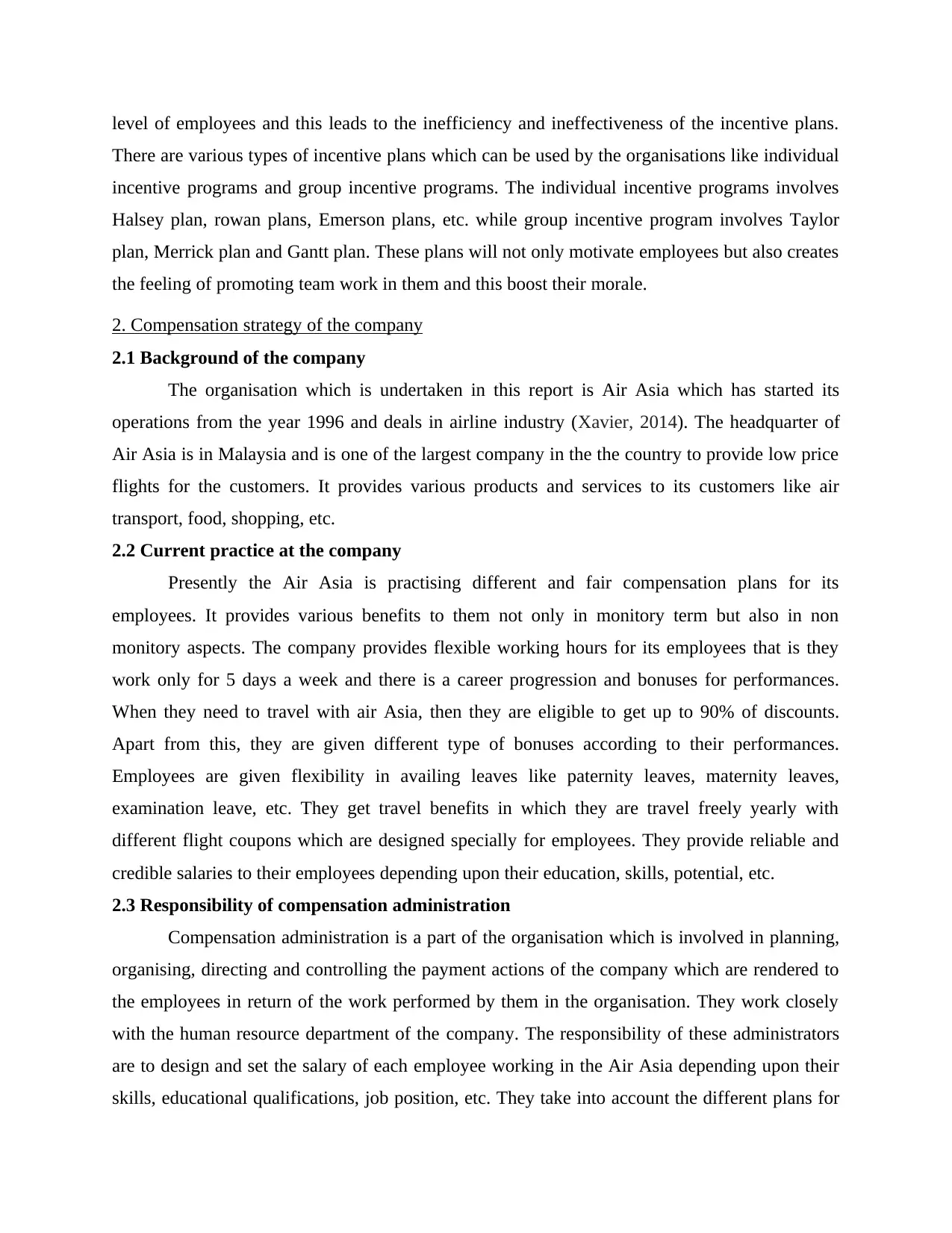
level of employees and this leads to the inefficiency and ineffectiveness of the incentive plans.
There are various types of incentive plans which can be used by the organisations like individual
incentive programs and group incentive programs. The individual incentive programs involves
Halsey plan, rowan plans, Emerson plans, etc. while group incentive program involves Taylor
plan, Merrick plan and Gantt plan. These plans will not only motivate employees but also creates
the feeling of promoting team work in them and this boost their morale.
2. Compensation strategy of the company
2.1 Background of the company
The organisation which is undertaken in this report is Air Asia which has started its
operations from the year 1996 and deals in airline industry (Xavier, 2014). The headquarter of
Air Asia is in Malaysia and is one of the largest company in the the country to provide low price
flights for the customers. It provides various products and services to its customers like air
transport, food, shopping, etc.
2.2 Current practice at the company
Presently the Air Asia is practising different and fair compensation plans for its
employees. It provides various benefits to them not only in monitory term but also in non
monitory aspects. The company provides flexible working hours for its employees that is they
work only for 5 days a week and there is a career progression and bonuses for performances.
When they need to travel with air Asia, then they are eligible to get up to 90% of discounts.
Apart from this, they are given different type of bonuses according to their performances.
Employees are given flexibility in availing leaves like paternity leaves, maternity leaves,
examination leave, etc. They get travel benefits in which they are travel freely yearly with
different flight coupons which are designed specially for employees. They provide reliable and
credible salaries to their employees depending upon their education, skills, potential, etc.
2.3 Responsibility of compensation administration
Compensation administration is a part of the organisation which is involved in planning,
organising, directing and controlling the payment actions of the company which are rendered to
the employees in return of the work performed by them in the organisation. They work closely
with the human resource department of the company. The responsibility of these administrators
are to design and set the salary of each employee working in the Air Asia depending upon their
skills, educational qualifications, job position, etc. They take into account the different plans for
There are various types of incentive plans which can be used by the organisations like individual
incentive programs and group incentive programs. The individual incentive programs involves
Halsey plan, rowan plans, Emerson plans, etc. while group incentive program involves Taylor
plan, Merrick plan and Gantt plan. These plans will not only motivate employees but also creates
the feeling of promoting team work in them and this boost their morale.
2. Compensation strategy of the company
2.1 Background of the company
The organisation which is undertaken in this report is Air Asia which has started its
operations from the year 1996 and deals in airline industry (Xavier, 2014). The headquarter of
Air Asia is in Malaysia and is one of the largest company in the the country to provide low price
flights for the customers. It provides various products and services to its customers like air
transport, food, shopping, etc.
2.2 Current practice at the company
Presently the Air Asia is practising different and fair compensation plans for its
employees. It provides various benefits to them not only in monitory term but also in non
monitory aspects. The company provides flexible working hours for its employees that is they
work only for 5 days a week and there is a career progression and bonuses for performances.
When they need to travel with air Asia, then they are eligible to get up to 90% of discounts.
Apart from this, they are given different type of bonuses according to their performances.
Employees are given flexibility in availing leaves like paternity leaves, maternity leaves,
examination leave, etc. They get travel benefits in which they are travel freely yearly with
different flight coupons which are designed specially for employees. They provide reliable and
credible salaries to their employees depending upon their education, skills, potential, etc.
2.3 Responsibility of compensation administration
Compensation administration is a part of the organisation which is involved in planning,
organising, directing and controlling the payment actions of the company which are rendered to
the employees in return of the work performed by them in the organisation. They work closely
with the human resource department of the company. The responsibility of these administrators
are to design and set the salary of each employee working in the Air Asia depending upon their
skills, educational qualifications, job position, etc. They take into account the different plans for
Paraphrase This Document
Need a fresh take? Get an instant paraphrase of this document with our AI Paraphraser
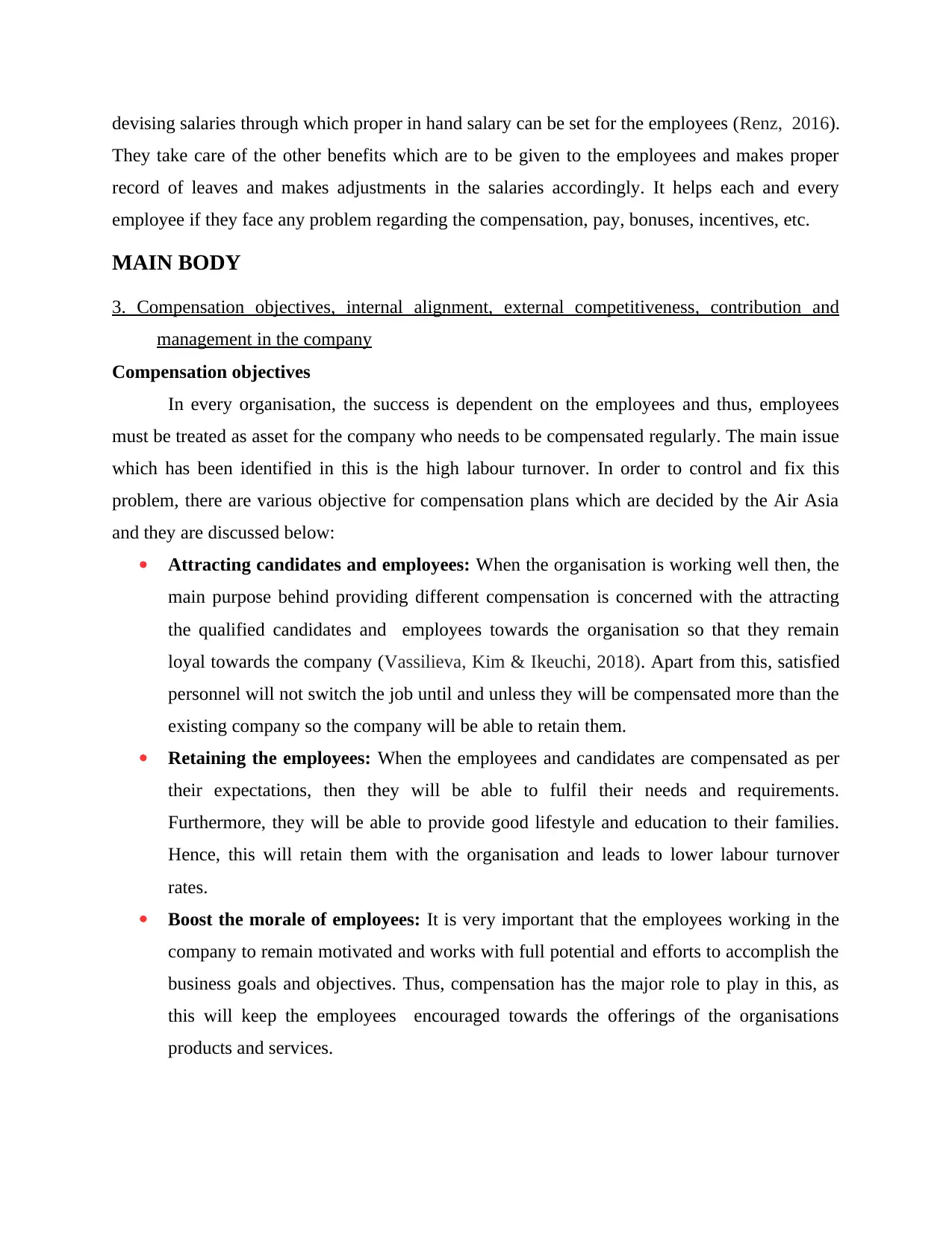
devising salaries through which proper in hand salary can be set for the employees (Renz, 2016).
They take care of the other benefits which are to be given to the employees and makes proper
record of leaves and makes adjustments in the salaries accordingly. It helps each and every
employee if they face any problem regarding the compensation, pay, bonuses, incentives, etc.
MAIN BODY
3. Compensation objectives, internal alignment, external competitiveness, contribution and
management in the company
Compensation objectives
In every organisation, the success is dependent on the employees and thus, employees
must be treated as asset for the company who needs to be compensated regularly. The main issue
which has been identified in this is the high labour turnover. In order to control and fix this
problem, there are various objective for compensation plans which are decided by the Air Asia
and they are discussed below:
Attracting candidates and employees: When the organisation is working well then, the
main purpose behind providing different compensation is concerned with the attracting
the qualified candidates and employees towards the organisation so that they remain
loyal towards the company (Vassilieva, Kim & Ikeuchi, 2018). Apart from this, satisfied
personnel will not switch the job until and unless they will be compensated more than the
existing company so the company will be able to retain them.
Retaining the employees: When the employees and candidates are compensated as per
their expectations, then they will be able to fulfil their needs and requirements.
Furthermore, they will be able to provide good lifestyle and education to their families.
Hence, this will retain them with the organisation and leads to lower labour turnover
rates.
Boost the morale of employees: It is very important that the employees working in the
company to remain motivated and works with full potential and efforts to accomplish the
business goals and objectives. Thus, compensation has the major role to play in this, as
this will keep the employees encouraged towards the offerings of the organisations
products and services.
They take care of the other benefits which are to be given to the employees and makes proper
record of leaves and makes adjustments in the salaries accordingly. It helps each and every
employee if they face any problem regarding the compensation, pay, bonuses, incentives, etc.
MAIN BODY
3. Compensation objectives, internal alignment, external competitiveness, contribution and
management in the company
Compensation objectives
In every organisation, the success is dependent on the employees and thus, employees
must be treated as asset for the company who needs to be compensated regularly. The main issue
which has been identified in this is the high labour turnover. In order to control and fix this
problem, there are various objective for compensation plans which are decided by the Air Asia
and they are discussed below:
Attracting candidates and employees: When the organisation is working well then, the
main purpose behind providing different compensation is concerned with the attracting
the qualified candidates and employees towards the organisation so that they remain
loyal towards the company (Vassilieva, Kim & Ikeuchi, 2018). Apart from this, satisfied
personnel will not switch the job until and unless they will be compensated more than the
existing company so the company will be able to retain them.
Retaining the employees: When the employees and candidates are compensated as per
their expectations, then they will be able to fulfil their needs and requirements.
Furthermore, they will be able to provide good lifestyle and education to their families.
Hence, this will retain them with the organisation and leads to lower labour turnover
rates.
Boost the morale of employees: It is very important that the employees working in the
company to remain motivated and works with full potential and efforts to accomplish the
business goals and objectives. Thus, compensation has the major role to play in this, as
this will keep the employees encouraged towards the offerings of the organisations
products and services.
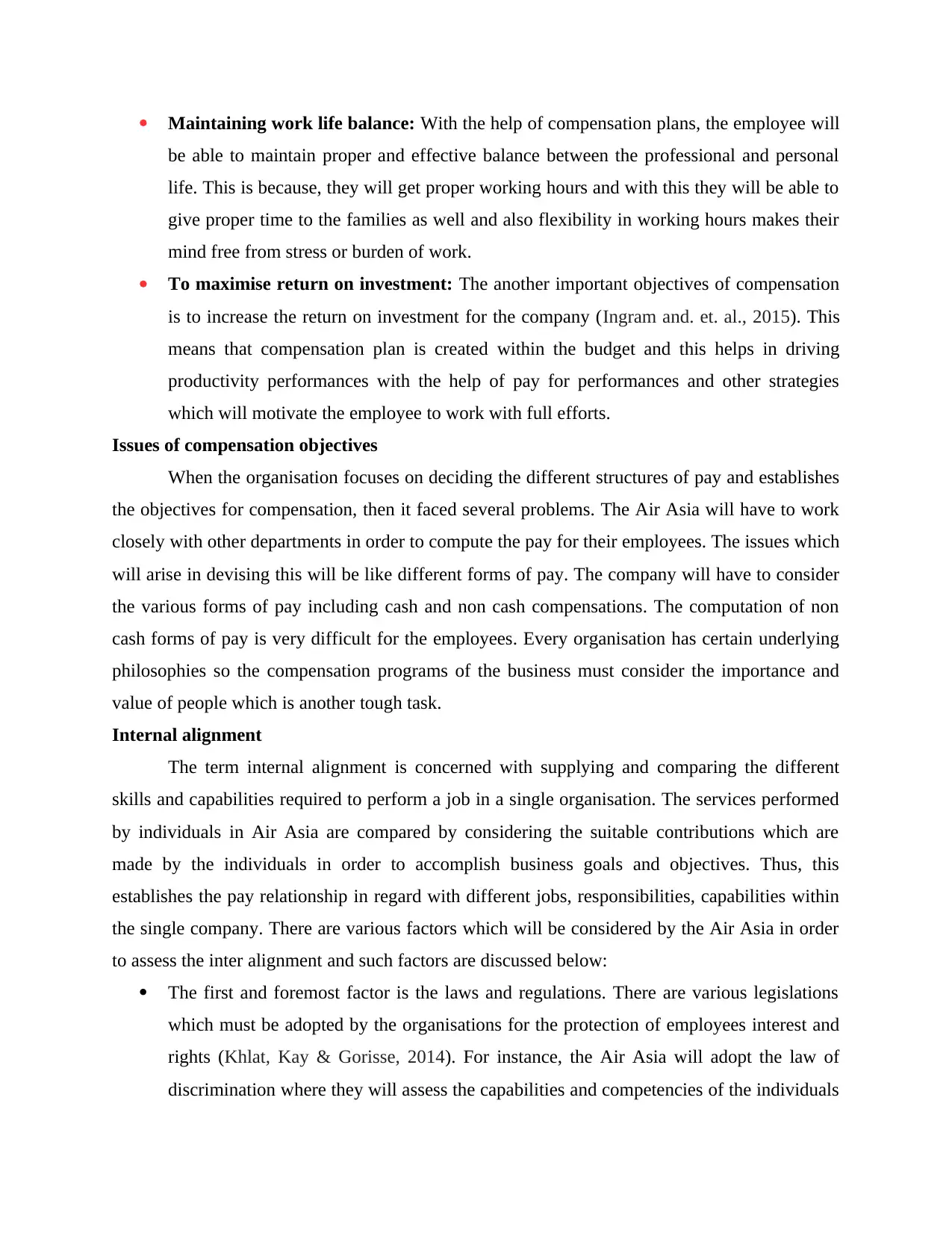
Maintaining work life balance: With the help of compensation plans, the employee will
be able to maintain proper and effective balance between the professional and personal
life. This is because, they will get proper working hours and with this they will be able to
give proper time to the families as well and also flexibility in working hours makes their
mind free from stress or burden of work.
To maximise return on investment: The another important objectives of compensation
is to increase the return on investment for the company (Ingram and. et. al., 2015). This
means that compensation plan is created within the budget and this helps in driving
productivity performances with the help of pay for performances and other strategies
which will motivate the employee to work with full efforts.
Issues of compensation objectives
When the organisation focuses on deciding the different structures of pay and establishes
the objectives for compensation, then it faced several problems. The Air Asia will have to work
closely with other departments in order to compute the pay for their employees. The issues which
will arise in devising this will be like different forms of pay. The company will have to consider
the various forms of pay including cash and non cash compensations. The computation of non
cash forms of pay is very difficult for the employees. Every organisation has certain underlying
philosophies so the compensation programs of the business must consider the importance and
value of people which is another tough task.
Internal alignment
The term internal alignment is concerned with supplying and comparing the different
skills and capabilities required to perform a job in a single organisation. The services performed
by individuals in Air Asia are compared by considering the suitable contributions which are
made by the individuals in order to accomplish business goals and objectives. Thus, this
establishes the pay relationship in regard with different jobs, responsibilities, capabilities within
the single company. There are various factors which will be considered by the Air Asia in order
to assess the inter alignment and such factors are discussed below:
The first and foremost factor is the laws and regulations. There are various legislations
which must be adopted by the organisations for the protection of employees interest and
rights (Khlat, Kay & Gorisse, 2014). For instance, the Air Asia will adopt the law of
discrimination where they will assess the capabilities and competencies of the individuals
be able to maintain proper and effective balance between the professional and personal
life. This is because, they will get proper working hours and with this they will be able to
give proper time to the families as well and also flexibility in working hours makes their
mind free from stress or burden of work.
To maximise return on investment: The another important objectives of compensation
is to increase the return on investment for the company (Ingram and. et. al., 2015). This
means that compensation plan is created within the budget and this helps in driving
productivity performances with the help of pay for performances and other strategies
which will motivate the employee to work with full efforts.
Issues of compensation objectives
When the organisation focuses on deciding the different structures of pay and establishes
the objectives for compensation, then it faced several problems. The Air Asia will have to work
closely with other departments in order to compute the pay for their employees. The issues which
will arise in devising this will be like different forms of pay. The company will have to consider
the various forms of pay including cash and non cash compensations. The computation of non
cash forms of pay is very difficult for the employees. Every organisation has certain underlying
philosophies so the compensation programs of the business must consider the importance and
value of people which is another tough task.
Internal alignment
The term internal alignment is concerned with supplying and comparing the different
skills and capabilities required to perform a job in a single organisation. The services performed
by individuals in Air Asia are compared by considering the suitable contributions which are
made by the individuals in order to accomplish business goals and objectives. Thus, this
establishes the pay relationship in regard with different jobs, responsibilities, capabilities within
the single company. There are various factors which will be considered by the Air Asia in order
to assess the inter alignment and such factors are discussed below:
The first and foremost factor is the laws and regulations. There are various legislations
which must be adopted by the organisations for the protection of employees interest and
rights (Khlat, Kay & Gorisse, 2014). For instance, the Air Asia will adopt the law of
discrimination where they will assess the capabilities and competencies of the individuals
⊘ This is a preview!⊘
Do you want full access?
Subscribe today to unlock all pages.

Trusted by 1+ million students worldwide
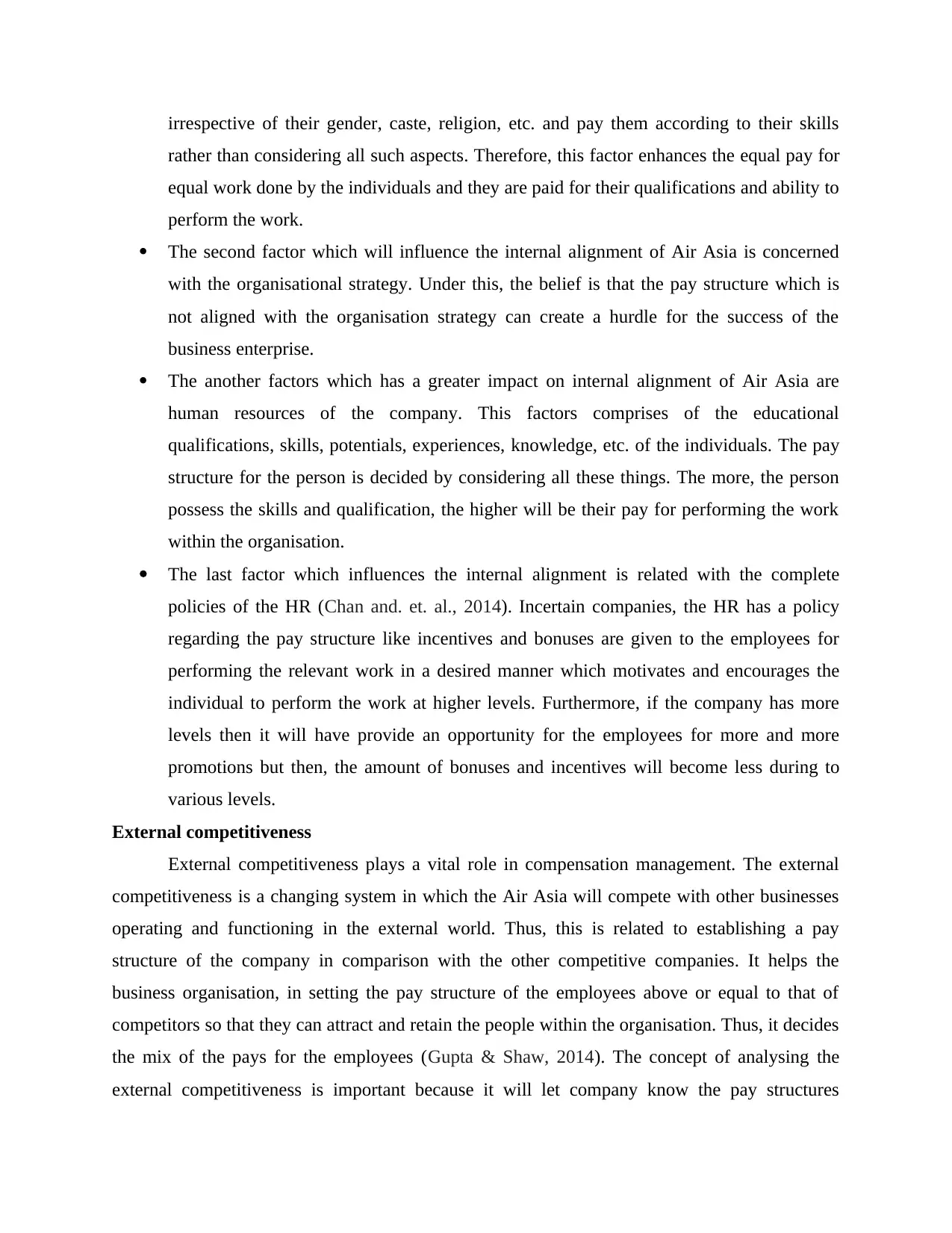
irrespective of their gender, caste, religion, etc. and pay them according to their skills
rather than considering all such aspects. Therefore, this factor enhances the equal pay for
equal work done by the individuals and they are paid for their qualifications and ability to
perform the work.
The second factor which will influence the internal alignment of Air Asia is concerned
with the organisational strategy. Under this, the belief is that the pay structure which is
not aligned with the organisation strategy can create a hurdle for the success of the
business enterprise.
The another factors which has a greater impact on internal alignment of Air Asia are
human resources of the company. This factors comprises of the educational
qualifications, skills, potentials, experiences, knowledge, etc. of the individuals. The pay
structure for the person is decided by considering all these things. The more, the person
possess the skills and qualification, the higher will be their pay for performing the work
within the organisation.
The last factor which influences the internal alignment is related with the complete
policies of the HR (Chan and. et. al., 2014). Incertain companies, the HR has a policy
regarding the pay structure like incentives and bonuses are given to the employees for
performing the relevant work in a desired manner which motivates and encourages the
individual to perform the work at higher levels. Furthermore, if the company has more
levels then it will have provide an opportunity for the employees for more and more
promotions but then, the amount of bonuses and incentives will become less during to
various levels.
External competitiveness
External competitiveness plays a vital role in compensation management. The external
competitiveness is a changing system in which the Air Asia will compete with other businesses
operating and functioning in the external world. Thus, this is related to establishing a pay
structure of the company in comparison with the other competitive companies. It helps the
business organisation, in setting the pay structure of the employees above or equal to that of
competitors so that they can attract and retain the people within the organisation. Thus, it decides
the mix of the pays for the employees (Gupta & Shaw, 2014). The concept of analysing the
external competitiveness is important because it will let company know the pay structures
rather than considering all such aspects. Therefore, this factor enhances the equal pay for
equal work done by the individuals and they are paid for their qualifications and ability to
perform the work.
The second factor which will influence the internal alignment of Air Asia is concerned
with the organisational strategy. Under this, the belief is that the pay structure which is
not aligned with the organisation strategy can create a hurdle for the success of the
business enterprise.
The another factors which has a greater impact on internal alignment of Air Asia are
human resources of the company. This factors comprises of the educational
qualifications, skills, potentials, experiences, knowledge, etc. of the individuals. The pay
structure for the person is decided by considering all these things. The more, the person
possess the skills and qualification, the higher will be their pay for performing the work
within the organisation.
The last factor which influences the internal alignment is related with the complete
policies of the HR (Chan and. et. al., 2014). Incertain companies, the HR has a policy
regarding the pay structure like incentives and bonuses are given to the employees for
performing the relevant work in a desired manner which motivates and encourages the
individual to perform the work at higher levels. Furthermore, if the company has more
levels then it will have provide an opportunity for the employees for more and more
promotions but then, the amount of bonuses and incentives will become less during to
various levels.
External competitiveness
External competitiveness plays a vital role in compensation management. The external
competitiveness is a changing system in which the Air Asia will compete with other businesses
operating and functioning in the external world. Thus, this is related to establishing a pay
structure of the company in comparison with the other competitive companies. It helps the
business organisation, in setting the pay structure of the employees above or equal to that of
competitors so that they can attract and retain the people within the organisation. Thus, it decides
the mix of the pays for the employees (Gupta & Shaw, 2014). The concept of analysing the
external competitiveness is important because it will let company know the pay structures
Paraphrase This Document
Need a fresh take? Get an instant paraphrase of this document with our AI Paraphraser
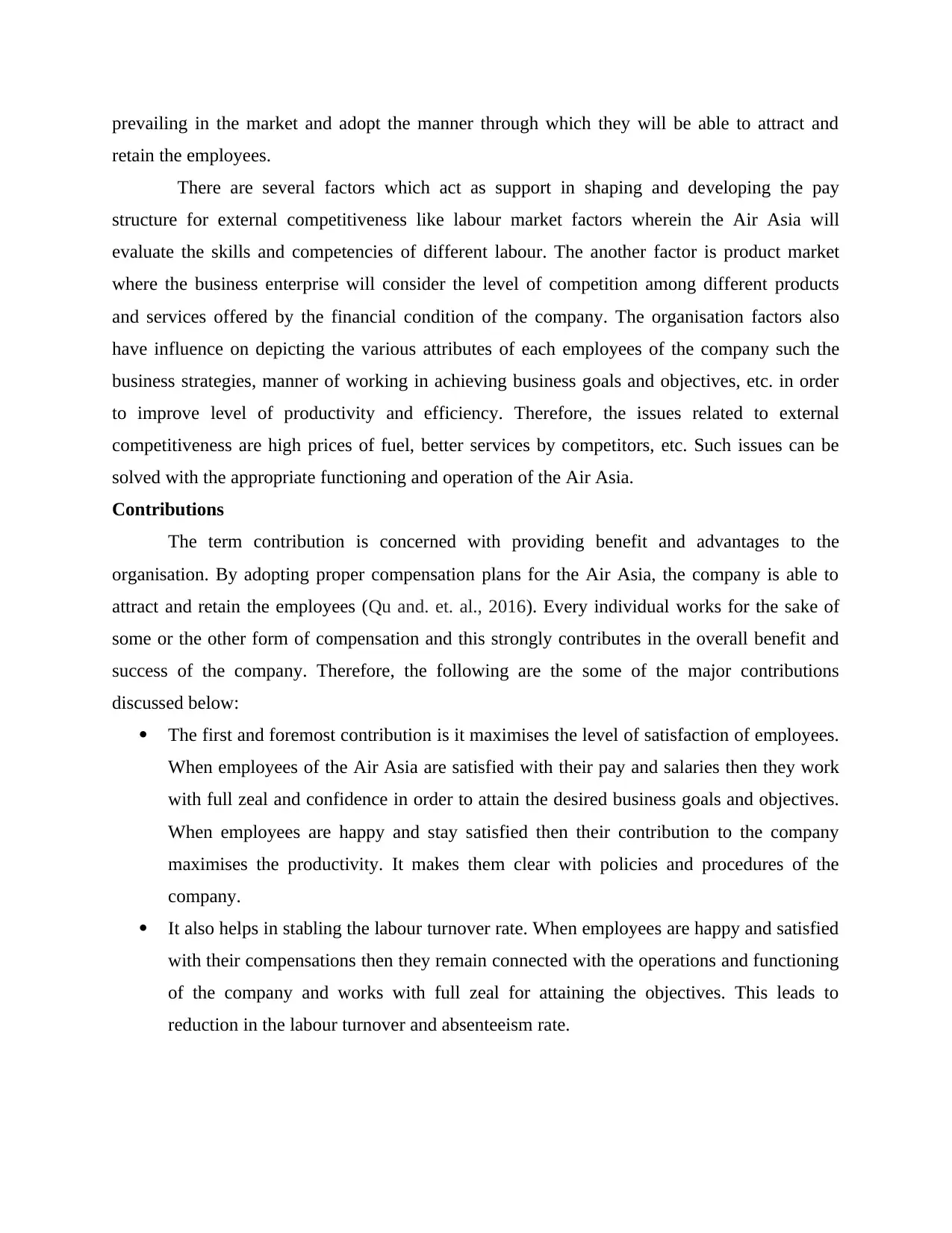
prevailing in the market and adopt the manner through which they will be able to attract and
retain the employees.
There are several factors which act as support in shaping and developing the pay
structure for external competitiveness like labour market factors wherein the Air Asia will
evaluate the skills and competencies of different labour. The another factor is product market
where the business enterprise will consider the level of competition among different products
and services offered by the financial condition of the company. The organisation factors also
have influence on depicting the various attributes of each employees of the company such the
business strategies, manner of working in achieving business goals and objectives, etc. in order
to improve level of productivity and efficiency. Therefore, the issues related to external
competitiveness are high prices of fuel, better services by competitors, etc. Such issues can be
solved with the appropriate functioning and operation of the Air Asia.
Contributions
The term contribution is concerned with providing benefit and advantages to the
organisation. By adopting proper compensation plans for the Air Asia, the company is able to
attract and retain the employees (Qu and. et. al., 2016). Every individual works for the sake of
some or the other form of compensation and this strongly contributes in the overall benefit and
success of the company. Therefore, the following are the some of the major contributions
discussed below:
The first and foremost contribution is it maximises the level of satisfaction of employees.
When employees of the Air Asia are satisfied with their pay and salaries then they work
with full zeal and confidence in order to attain the desired business goals and objectives.
When employees are happy and stay satisfied then their contribution to the company
maximises the productivity. It makes them clear with policies and procedures of the
company.
It also helps in stabling the labour turnover rate. When employees are happy and satisfied
with their compensations then they remain connected with the operations and functioning
of the company and works with full zeal for attaining the objectives. This leads to
reduction in the labour turnover and absenteeism rate.
retain the employees.
There are several factors which act as support in shaping and developing the pay
structure for external competitiveness like labour market factors wherein the Air Asia will
evaluate the skills and competencies of different labour. The another factor is product market
where the business enterprise will consider the level of competition among different products
and services offered by the financial condition of the company. The organisation factors also
have influence on depicting the various attributes of each employees of the company such the
business strategies, manner of working in achieving business goals and objectives, etc. in order
to improve level of productivity and efficiency. Therefore, the issues related to external
competitiveness are high prices of fuel, better services by competitors, etc. Such issues can be
solved with the appropriate functioning and operation of the Air Asia.
Contributions
The term contribution is concerned with providing benefit and advantages to the
organisation. By adopting proper compensation plans for the Air Asia, the company is able to
attract and retain the employees (Qu and. et. al., 2016). Every individual works for the sake of
some or the other form of compensation and this strongly contributes in the overall benefit and
success of the company. Therefore, the following are the some of the major contributions
discussed below:
The first and foremost contribution is it maximises the level of satisfaction of employees.
When employees of the Air Asia are satisfied with their pay and salaries then they work
with full zeal and confidence in order to attain the desired business goals and objectives.
When employees are happy and stay satisfied then their contribution to the company
maximises the productivity. It makes them clear with policies and procedures of the
company.
It also helps in stabling the labour turnover rate. When employees are happy and satisfied
with their compensations then they remain connected with the operations and functioning
of the company and works with full zeal for attaining the objectives. This leads to
reduction in the labour turnover and absenteeism rate.
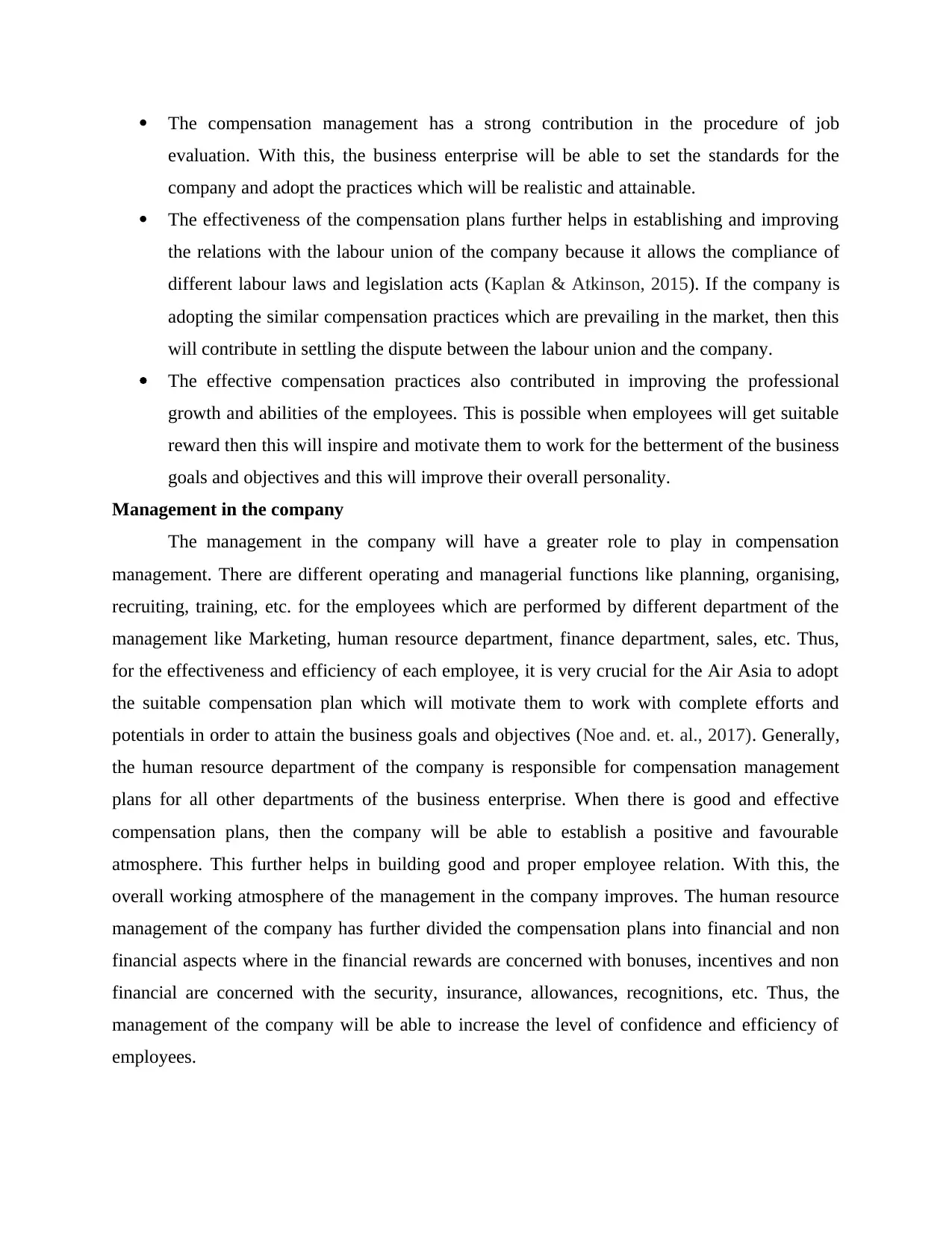
The compensation management has a strong contribution in the procedure of job
evaluation. With this, the business enterprise will be able to set the standards for the
company and adopt the practices which will be realistic and attainable.
The effectiveness of the compensation plans further helps in establishing and improving
the relations with the labour union of the company because it allows the compliance of
different labour laws and legislation acts (Kaplan & Atkinson, 2015). If the company is
adopting the similar compensation practices which are prevailing in the market, then this
will contribute in settling the dispute between the labour union and the company.
The effective compensation practices also contributed in improving the professional
growth and abilities of the employees. This is possible when employees will get suitable
reward then this will inspire and motivate them to work for the betterment of the business
goals and objectives and this will improve their overall personality.
Management in the company
The management in the company will have a greater role to play in compensation
management. There are different operating and managerial functions like planning, organising,
recruiting, training, etc. for the employees which are performed by different department of the
management like Marketing, human resource department, finance department, sales, etc. Thus,
for the effectiveness and efficiency of each employee, it is very crucial for the Air Asia to adopt
the suitable compensation plan which will motivate them to work with complete efforts and
potentials in order to attain the business goals and objectives (Noe and. et. al., 2017). Generally,
the human resource department of the company is responsible for compensation management
plans for all other departments of the business enterprise. When there is good and effective
compensation plans, then the company will be able to establish a positive and favourable
atmosphere. This further helps in building good and proper employee relation. With this, the
overall working atmosphere of the management in the company improves. The human resource
management of the company has further divided the compensation plans into financial and non
financial aspects where in the financial rewards are concerned with bonuses, incentives and non
financial are concerned with the security, insurance, allowances, recognitions, etc. Thus, the
management of the company will be able to increase the level of confidence and efficiency of
employees.
evaluation. With this, the business enterprise will be able to set the standards for the
company and adopt the practices which will be realistic and attainable.
The effectiveness of the compensation plans further helps in establishing and improving
the relations with the labour union of the company because it allows the compliance of
different labour laws and legislation acts (Kaplan & Atkinson, 2015). If the company is
adopting the similar compensation practices which are prevailing in the market, then this
will contribute in settling the dispute between the labour union and the company.
The effective compensation practices also contributed in improving the professional
growth and abilities of the employees. This is possible when employees will get suitable
reward then this will inspire and motivate them to work for the betterment of the business
goals and objectives and this will improve their overall personality.
Management in the company
The management in the company will have a greater role to play in compensation
management. There are different operating and managerial functions like planning, organising,
recruiting, training, etc. for the employees which are performed by different department of the
management like Marketing, human resource department, finance department, sales, etc. Thus,
for the effectiveness and efficiency of each employee, it is very crucial for the Air Asia to adopt
the suitable compensation plan which will motivate them to work with complete efforts and
potentials in order to attain the business goals and objectives (Noe and. et. al., 2017). Generally,
the human resource department of the company is responsible for compensation management
plans for all other departments of the business enterprise. When there is good and effective
compensation plans, then the company will be able to establish a positive and favourable
atmosphere. This further helps in building good and proper employee relation. With this, the
overall working atmosphere of the management in the company improves. The human resource
management of the company has further divided the compensation plans into financial and non
financial aspects where in the financial rewards are concerned with bonuses, incentives and non
financial are concerned with the security, insurance, allowances, recognitions, etc. Thus, the
management of the company will be able to increase the level of confidence and efficiency of
employees.
⊘ This is a preview!⊘
Do you want full access?
Subscribe today to unlock all pages.

Trusted by 1+ million students worldwide

4. CONCLUSION
From the above discussion, it has been concluded that compensation management is very
important in current business world for the betterment of the employees. The competition among
the companies are increasing at a rapid rate and for this reason the companies are highly
concentrating on the pay structures. The compensation plan helps in retaining and attracting the
employees towards the company. It act as a powerful support for stimulating the employees in
order to improve the level of productivity and efficiency.
From the above discussion, it has been concluded that compensation management is very
important in current business world for the betterment of the employees. The competition among
the companies are increasing at a rapid rate and for this reason the companies are highly
concentrating on the pay structures. The compensation plan helps in retaining and attracting the
employees towards the company. It act as a powerful support for stimulating the employees in
order to improve the level of productivity and efficiency.
Paraphrase This Document
Need a fresh take? Get an instant paraphrase of this document with our AI Paraphraser
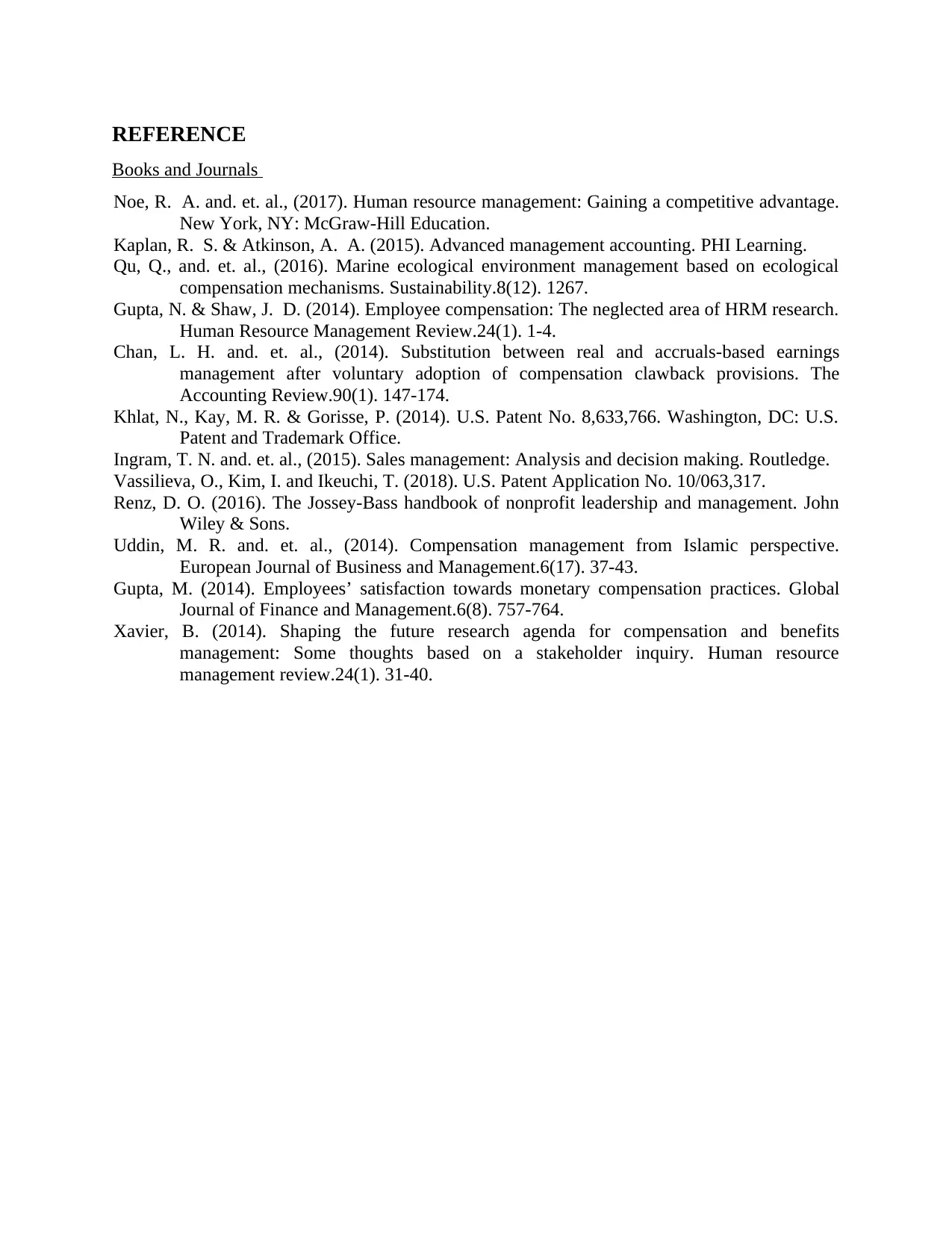
REFERENCE
Books and Journals
Noe, R. A. and. et. al., (2017). Human resource management: Gaining a competitive advantage.
New York, NY: McGraw-Hill Education.
Kaplan, R. S. & Atkinson, A. A. (2015). Advanced management accounting. PHI Learning.
Qu, Q., and. et. al., (2016). Marine ecological environment management based on ecological
compensation mechanisms. Sustainability.8(12). 1267.
Gupta, N. & Shaw, J. D. (2014). Employee compensation: The neglected area of HRM research.
Human Resource Management Review.24(1). 1-4.
Chan, L. H. and. et. al., (2014). Substitution between real and accruals-based earnings
management after voluntary adoption of compensation clawback provisions. The
Accounting Review.90(1). 147-174.
Khlat, N., Kay, M. R. & Gorisse, P. (2014). U.S. Patent No. 8,633,766. Washington, DC: U.S.
Patent and Trademark Office.
Ingram, T. N. and. et. al., (2015). Sales management: Analysis and decision making. Routledge.
Vassilieva, O., Kim, I. and Ikeuchi, T. (2018). U.S. Patent Application No. 10/063,317.
Renz, D. O. (2016). The Jossey-Bass handbook of nonprofit leadership and management. John
Wiley & Sons.
Uddin, M. R. and. et. al., (2014). Compensation management from Islamic perspective.
European Journal of Business and Management.6(17). 37-43.
Gupta, M. (2014). Employees’ satisfaction towards monetary compensation practices. Global
Journal of Finance and Management.6(8). 757-764.
Xavier, B. (2014). Shaping the future research agenda for compensation and benefits
management: Some thoughts based on a stakeholder inquiry. Human resource
management review.24(1). 31-40.
Books and Journals
Noe, R. A. and. et. al., (2017). Human resource management: Gaining a competitive advantage.
New York, NY: McGraw-Hill Education.
Kaplan, R. S. & Atkinson, A. A. (2015). Advanced management accounting. PHI Learning.
Qu, Q., and. et. al., (2016). Marine ecological environment management based on ecological
compensation mechanisms. Sustainability.8(12). 1267.
Gupta, N. & Shaw, J. D. (2014). Employee compensation: The neglected area of HRM research.
Human Resource Management Review.24(1). 1-4.
Chan, L. H. and. et. al., (2014). Substitution between real and accruals-based earnings
management after voluntary adoption of compensation clawback provisions. The
Accounting Review.90(1). 147-174.
Khlat, N., Kay, M. R. & Gorisse, P. (2014). U.S. Patent No. 8,633,766. Washington, DC: U.S.
Patent and Trademark Office.
Ingram, T. N. and. et. al., (2015). Sales management: Analysis and decision making. Routledge.
Vassilieva, O., Kim, I. and Ikeuchi, T. (2018). U.S. Patent Application No. 10/063,317.
Renz, D. O. (2016). The Jossey-Bass handbook of nonprofit leadership and management. John
Wiley & Sons.
Uddin, M. R. and. et. al., (2014). Compensation management from Islamic perspective.
European Journal of Business and Management.6(17). 37-43.
Gupta, M. (2014). Employees’ satisfaction towards monetary compensation practices. Global
Journal of Finance and Management.6(8). 757-764.
Xavier, B. (2014). Shaping the future research agenda for compensation and benefits
management: Some thoughts based on a stakeholder inquiry. Human resource
management review.24(1). 31-40.
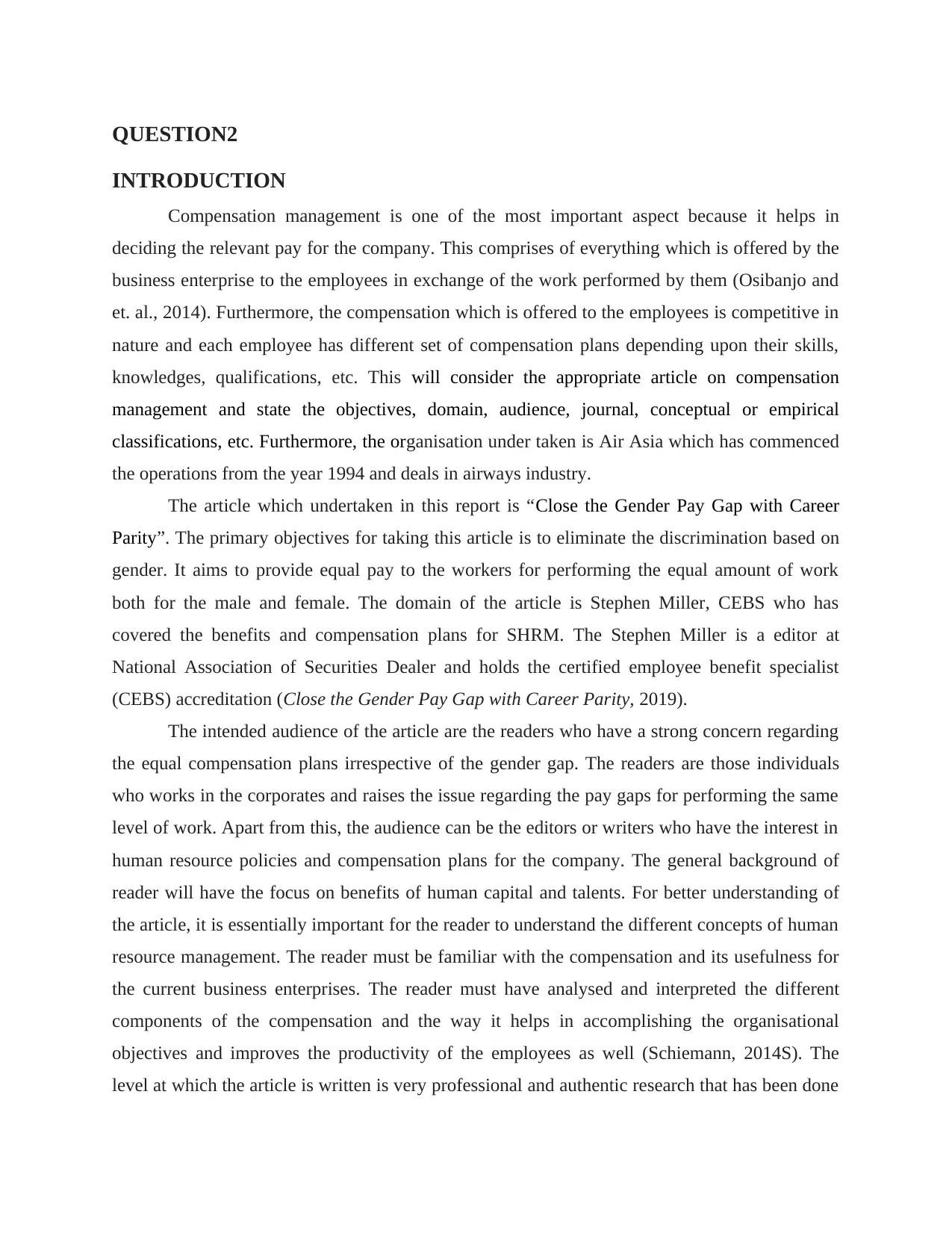
QUESTION2
INTRODUCTION
Compensation management is one of the most important aspect because it helps in
deciding the relevant pay for the company. This comprises of everything which is offered by the
business enterprise to the employees in exchange of the work performed by them (Osibanjo and
et. al., 2014). Furthermore, the compensation which is offered to the employees is competitive in
nature and each employee has different set of compensation plans depending upon their skills,
knowledges, qualifications, etc. This will consider the appropriate article on compensation
management and state the objectives, domain, audience, journal, conceptual or empirical
classifications, etc. Furthermore, the organisation under taken is Air Asia which has commenced
the operations from the year 1994 and deals in airways industry.
The article which undertaken in this report is “Close the Gender Pay Gap with Career
Parity”. The primary objectives for taking this article is to eliminate the discrimination based on
gender. It aims to provide equal pay to the workers for performing the equal amount of work
both for the male and female. The domain of the article is Stephen Miller, CEBS who has
covered the benefits and compensation plans for SHRM. The Stephen Miller is a editor at
National Association of Securities Dealer and holds the certified employee benefit specialist
(CEBS) accreditation (Close the Gender Pay Gap with Career Parity, 2019).
The intended audience of the article are the readers who have a strong concern regarding
the equal compensation plans irrespective of the gender gap. The readers are those individuals
who works in the corporates and raises the issue regarding the pay gaps for performing the same
level of work. Apart from this, the audience can be the editors or writers who have the interest in
human resource policies and compensation plans for the company. The general background of
reader will have the focus on benefits of human capital and talents. For better understanding of
the article, it is essentially important for the reader to understand the different concepts of human
resource management. The reader must be familiar with the compensation and its usefulness for
the current business enterprises. The reader must have analysed and interpreted the different
components of the compensation and the way it helps in accomplishing the organisational
objectives and improves the productivity of the employees as well (Schiemann, 2014S). The
level at which the article is written is very professional and authentic research that has been done
INTRODUCTION
Compensation management is one of the most important aspect because it helps in
deciding the relevant pay for the company. This comprises of everything which is offered by the
business enterprise to the employees in exchange of the work performed by them (Osibanjo and
et. al., 2014). Furthermore, the compensation which is offered to the employees is competitive in
nature and each employee has different set of compensation plans depending upon their skills,
knowledges, qualifications, etc. This will consider the appropriate article on compensation
management and state the objectives, domain, audience, journal, conceptual or empirical
classifications, etc. Furthermore, the organisation under taken is Air Asia which has commenced
the operations from the year 1994 and deals in airways industry.
The article which undertaken in this report is “Close the Gender Pay Gap with Career
Parity”. The primary objectives for taking this article is to eliminate the discrimination based on
gender. It aims to provide equal pay to the workers for performing the equal amount of work
both for the male and female. The domain of the article is Stephen Miller, CEBS who has
covered the benefits and compensation plans for SHRM. The Stephen Miller is a editor at
National Association of Securities Dealer and holds the certified employee benefit specialist
(CEBS) accreditation (Close the Gender Pay Gap with Career Parity, 2019).
The intended audience of the article are the readers who have a strong concern regarding
the equal compensation plans irrespective of the gender gap. The readers are those individuals
who works in the corporates and raises the issue regarding the pay gaps for performing the same
level of work. Apart from this, the audience can be the editors or writers who have the interest in
human resource policies and compensation plans for the company. The general background of
reader will have the focus on benefits of human capital and talents. For better understanding of
the article, it is essentially important for the reader to understand the different concepts of human
resource management. The reader must be familiar with the compensation and its usefulness for
the current business enterprises. The reader must have analysed and interpreted the different
components of the compensation and the way it helps in accomplishing the organisational
objectives and improves the productivity of the employees as well (Schiemann, 2014S). The
level at which the article is written is very professional and authentic research that has been done
⊘ This is a preview!⊘
Do you want full access?
Subscribe today to unlock all pages.

Trusted by 1+ million students worldwide
1 out of 20
Related Documents
Your All-in-One AI-Powered Toolkit for Academic Success.
+13062052269
info@desklib.com
Available 24*7 on WhatsApp / Email
![[object Object]](/_next/static/media/star-bottom.7253800d.svg)
Unlock your academic potential
Copyright © 2020–2025 A2Z Services. All Rights Reserved. Developed and managed by ZUCOL.





